Name John McCormack Movies Song o' My Heart | Role Tenor | |
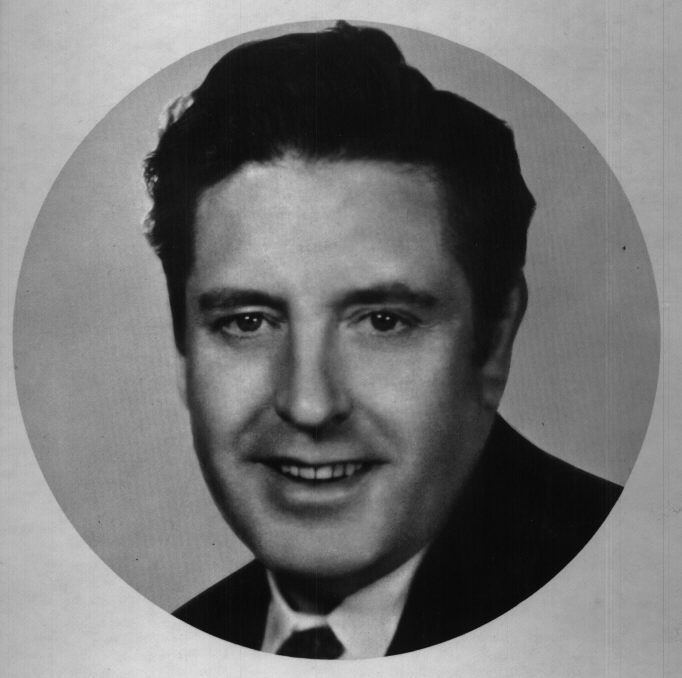 | ||
Spouse Lily Foley McCormack (m. 1906–1945) Albums Icon of an Age., Irish Songs Similar People Josef Locke, Frank Patterson, Fritz Kreisler, Billy Murray, Nellie Melba | ||
John Francis, Count McCormack, KSG, KSS, KHS (14 June 1884 – 16 September 1945) was a world-famous Irish-American tenor, celebrated for his performances of the operatic and popular song repertoires, and renowned for his diction and breath control. He was also a Papal Count.
Contents
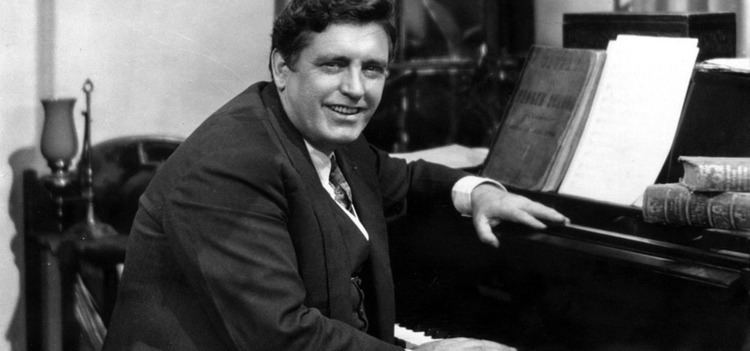
Early life
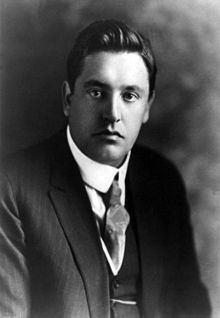
Count McCormack was born in Athlone, County Westmeath, Ireland, the fourth of eleven children of Andrew McCormack and Hannah Watson on 14 June 1884, and was baptised in St. Mary's Church, Athlone, on 23 June 1884. His parents were employed at the Athlone Woollen Mills.
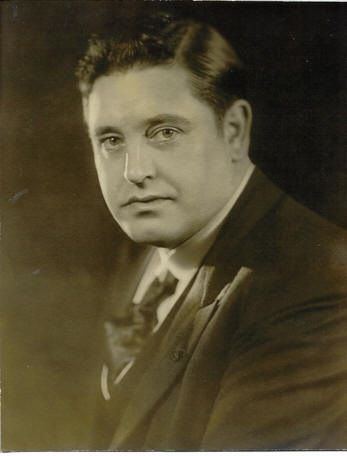
McCormack received his early education from the Marist Brothers in Athlone, and he later attended Summerhill College, Sligo. He sang in the choir of the old St. Peters church in Athlone under his choirmaster Michael Kilkelly. When the family moved to Dublin, he sang in the choir of St Mary's Pro-Cathedral where he was discovered by Vincent O'Brien. In 1903 he won the coveted gold medal of the Dublin Feis Ceoil. He married Lily Foley in 1906 and they had two children, Cyril and Gwen.
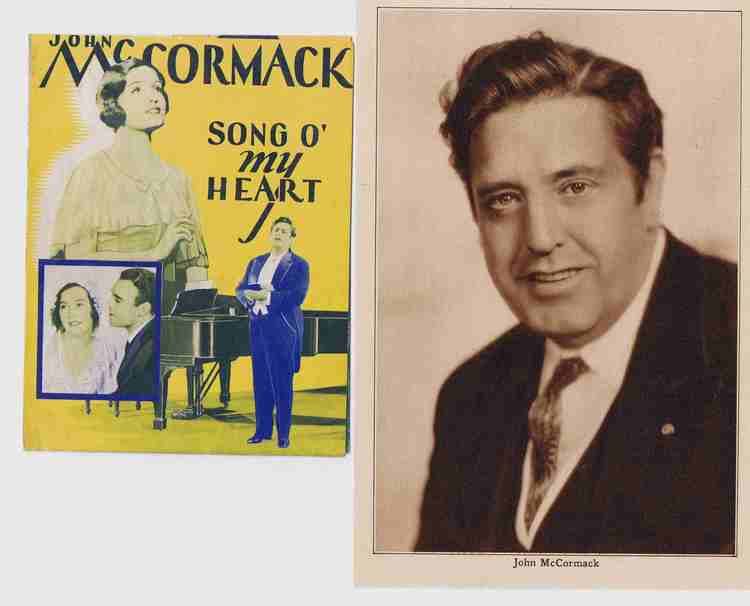
In March 1904, McCormack became associated with James Joyce, who at the time had singing ambitions himself. Richard Ellmann, in his biography of Joyce, states that "Joyce spent several evenings with him" (i.e. McCormack), practising; along with Joyce's acquaintance Richard Best, McCormack persuaded Joyce to enter the Feis Ceoil that year.
Career

Fundraising activities on his behalf enabled McCormack to travel to Italy in 1905 to receive voice training by Vincenzo Sabatini (father of the novelist Rafael Sabatini) in Milan. Sabatini found McCormack's voice naturally tuned and concentrated on perfecting his breath control, an element that would become part of the basis of his renown as a vocalist.
In 1906, he made his operatic debut at the Teatro Chiabrera, Savona. The next year he began his first important operatic performance at Covent Garden in Mascagni's Cavalleria rusticana, becoming the theatre's youngest principal tenor. In 1909 he began his career in America. Michael Scott ("The Record of Singing" 1978) writes that at this stage of his career he should be considered a tenor of the Italian style—and he sang (and recorded) French operatic arias in the Italian language. Steane ("The Grand Tradition" 1971) stresses that, for all his later devotion to the concert platform (and his Irish identity), he was (for albeit a relatively brief period) in essence an Italian operatic tenor.
In February 1911, McCormack played Lieutenant Paul Merrill in the world premiere of Victor Herbert's drama Natoma with Mary Garden in the title role. Later that year he toured Australia after Dame Nellie Melba engaged him, then at the height of his operatic career aged 27, as a star tenor for the Melba Grand Opera Season. He returned for concert tours in subsequent years.
By 1912, he was beginning to become involved increasingly with concert performances, where his voice quality and charisma ensured that he became the most celebrated lyric tenor of his time. He did not, however, retire from the operatic stage until after his performance of 1923 in Monte Carlo (see biography below), although by then the top notes of his voice had contracted. Famous for his extraordinary breath control, he could sing 64 notes on one breath in Mozart's Il mio tesoro from Don Giovanni, and his Handelian singing was just as impressive in this regard.
McCormack made hundreds of recordings, the first on phonograph cylinder in 1904. His most commercially successful series of records were those for the Victor Talking Machine Company during the 1910s and 1920s. He was Victor's most popular Red Seal recording artist after tenor Enrico Caruso. He also broadcast regularly by radio and performed in a few sound films, among them the first British three-strip Technicolor feature, Wings of the Morning (1937).
McCormack was one of the first artists to record the popular ballad "I Hear You Calling Me" written in 1908 by Harold Harford and Charles Marshall; he recorded it twice for Odeon starting in 1908 and a further four times for Victor between 1910 and 1927 – it became his best seller. He was the first artist to record the famous World War I song "It's a Long Way to Tipperary" in 1914. He also recorded the song "Keep The Home Fires Burning" in 1917, though he was not the first to do so. He also sang songs expressive of Irish nationalism — his recording of "The Wearing of the Green", a song about the Irish rebellion of 1798, encouraged 20th century efforts for Irish Home Rule — and endorsed the Irish Nationalist estrangement from the United Kingdom. McCormack was associated particularly with the songs of Thomas Moore, notably "The Harp That Once Through Tara's Halls", "The Minstrel Boy", "Believe Me If All (Those Endearing Young Charms)", and "The Last Rose of Summer". Between 1914 and 1922, he recorded almost two dozen songs with violin accompaniment provided by Fritz Kreisler, with whom he also toured. He recorded songs of Hugo Wolf for the Hugo Wolf Society in German. In 1918, he recorded the song "Calling Me Home to You".
In 1917, McCormack became a naturalised citizen of the United States. In June 1918, he donated $11,458 towards the USA's world war effort. By then, his career was a huge financial success, earning millions in his lifetime from record sales and appearances.
By 1920, Edwin Schneider had become McCormack's accompanist and the two were "inseparable". When Schneider retired, Gerald Moore took over as accompanist from 1939 to 1943.
In 1927, McCormack moved into Moore Abbey, Monasterevan, County Kildare, and lived an opulent life by Irish standards. He had apartments in London and New York. He hoped that one of his racehorses, such as Golden Lullaby, would win the Epsom Derby, but he was unlucky.
McCormack also bought Runyon Canyon in Hollywood in 1930 from Carman Runyon. McCormack saw and liked the estate while there filming Song o' My Heart (1930), an early all-talking, all-singing picture. McCormack used his salary for this movie to purchase the estate and built a mansion he called 'San Patrizio', after Saint Patrick. McCormack and his wife lived in the mansion until they returned to England in 1938.
McCormack toured often, and in his absence the mansion was often let to celebrities such as Janet Gaynor and Charles Boyer. The McCormacks made many friends in Hollywood, among them Will Rogers, John Barrymore, Basil Rathbone, Ronald Colman, Charles E. Toberman and the Dohenys. After his farewell tour of America in 1937, the McCormacks deeded the estate back to Carman Runyon expecting to return to the estate at a later date. World War II intervened and McCormack did not return.
McCormack originally ended his career at the Royal Albert Hall in London, during 1938. However, one year after that farewell concert, he was back singing for the Red Cross and in support of the war effort. He gave concerts, toured, broadcast and recorded in this capacity until 1943, when failing health finally forced him to retire permanently.
Ill with emphysema, he bought a house near the sea, "Glena", Booterstown, Dublin. After a series of infectious illnesses, including influenza and pneumonia, McCormack died in September 1945. He is buried in Deansgrange Cemetery.
Honours
McCormack was much honoured and decorated for his musical career. In 1928, he received the title of Papal Count from Pope Pius XI in recognition of his work for Catholic charities. He had earlier received three papal knighthoods, Knight of the Order of the Holy Sepulchre (KHS), Knight of the Order of St. Gregory the Great (KSG) and Knight of the Order of St. Sylvester (KSS). He was also a Knight of Malta and a Privy Chamberlain of the Sword and Cape, an honour which is known now as a Gentlemen of His Holiness.
One of the most famous acts of McCormack's Irish career was his singing of Cesar Franck's Panis Angelicus to the thousands who thronged Dublin's Phoenix Park for the 1932 Eucharistic Congress.
A life-sized bronze statue of McCormack by sculptor Elizabeth O'Kane was established in Dublin on 19 June 2008. The statue stands in the Iveagh Gardens, close to the National Concert Hall.
In his hometown of Athlone, he is commemorated by the Athlone Institute of Technology who named their performance hall after him, the John Count McCormack Hall.
He is also commemorated by an English Heritage blue plaque on the house near Hampstead in London, 24 Ferncroft Avenue, where he lived from 1908 until 1913.
A silver €10 collectors coin with a mintage of 8,000 pieces was issued by the Central Bank of Ireland in January 2014 featuring a portrait of McCormack; the coin was issued as part of the EUROPA star series in keeping with the 2014 theme of European musicians.
A statue of the tenor was unveiled in a square newly named in his honour outside the Civic Centre in Athlone on 24 October 2014. The sculpture, created by the Irish artist Rory Beslin, was celebrated by free admission to an exhibition of the celebrated singer's memorabilia.
Songs
It's a Long Way to Tipperary
When Irish Eyes Are Smiling
Keep the Home Fires Burning
Macushla
Roses of Picardy
I Hear You Calling Me
Oft in the Stilly Night
The Wearing of the Green
When You and I Were Young - Maggie
Kathleen Mavourneen
Mother Machree
My Wild Irish Rose
The Rose of Tralee
Where the River Shannon Flows
I'll Walk Beside You
The Kerry Dance
The Garden Where the Praties Grow
Somewhere a voice is calling
The Harp That Once Through Tara's Halls
Kashmiri Song
Angels Guard Thee
Molly Brannigan
Come Back to Erin
O Mary Dear
Ireland - Mother Ireland
Believe Me If All Those Endearing Young Charms
The Sunshine of Your Smile
Then You'll Remember Me
The Star of the County Down
The Snowy-Breasted Pearl
The Holy Child
She Is Far From the Land
